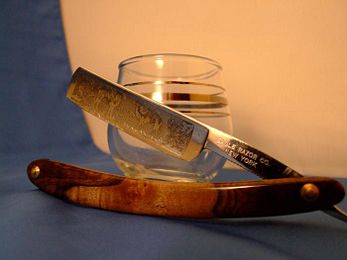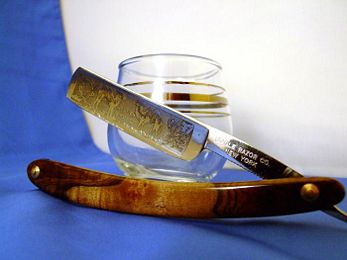Difference between revisions of "Lightbox Instructional"
m (categorizing) |
m (Re-categorised, and fixed markup.) |
||
| Line 3: | Line 3: | ||
Added to by [http://www.straightrazorplace.com/forums/workshop/22391-photography-straight-razors.html dhatcher] | Added to by [http://www.straightrazorplace.com/forums/workshop/22391-photography-straight-razors.html dhatcher] | ||
| − | |||
== Intro == | == Intro == | ||
| − | |||
Photograph your razors as if they were jewelry, because there is a certain technique to photographing jewelery that always produces those wonderfully magic magazine type images. The majority of this information deals with lighting, and the way the light reflects (or doesn't reflect) off the razor. You want to use what's called diffuse lighting (I know some people may or may not know what that means, so I'm not trying to offend anyone if it sounds a bit elementary). | Photograph your razors as if they were jewelry, because there is a certain technique to photographing jewelery that always produces those wonderfully magic magazine type images. The majority of this information deals with lighting, and the way the light reflects (or doesn't reflect) off the razor. You want to use what's called diffuse lighting (I know some people may or may not know what that means, so I'm not trying to offend anyone if it sounds a bit elementary). | ||
| − | + | ||
| − | |||
== What is diffuse lighting, and what do I need? == | == What is diffuse lighting, and what do I need? == | ||
| − | |||
Look at a light bulb in a lamp with no lamp shade... that is NOT diffused. Now look at it with the lamp shade, that is diffused (somewhat). Basically you diffuse light when you put something directly in front the light that is going to change the pattern of light after it goes through whatever material. Now generally pro photographers will use all kinds of fancy specially made diffusers and crap they buy because hey, they need tools and equipment that will serve them and last them a long time, just like anybody else who does a regular job or a furiously good hobbyist. | Look at a light bulb in a lamp with no lamp shade... that is NOT diffused. Now look at it with the lamp shade, that is diffused (somewhat). Basically you diffuse light when you put something directly in front the light that is going to change the pattern of light after it goes through whatever material. Now generally pro photographers will use all kinds of fancy specially made diffusers and crap they buy because hey, they need tools and equipment that will serve them and last them a long time, just like anybody else who does a regular job or a furiously good hobbyist. | ||
| Line 29: | Line 25: | ||
Try if you can to use a tripod (even for the digital point and shoots). The more still your camera is, the more likely you'll get a nice crisply focused picture (assuming you got your focus right ). | Try if you can to use a tripod (even for the digital point and shoots). The more still your camera is, the more likely you'll get a nice crisply focused picture (assuming you got your focus right ). | ||
| − | |||
| − | |||
I wanted to try to keep this on the simpler side, as most folks here probably haven't gotten into the whole DSLR world, and they just want to know what they can do to improve the photos they take with their point and shoots. | I wanted to try to keep this on the simpler side, as most folks here probably haven't gotten into the whole DSLR world, and they just want to know what they can do to improve the photos they take with their point and shoots. | ||
Oh and one more thing, definitely play with the settings on your own camera and really LEARN how it works. That will save you a lot of post processing frustration. | Oh and one more thing, definitely play with the settings on your own camera and really LEARN how it works. That will save you a lot of post processing frustration. | ||
| − | |||
| − | |||
---- | ---- | ||
'''Here are other sources for making your own Light Box:'''<br> | '''Here are other sources for making your own Light Box:'''<br> | ||
| − | [http://digital-photography-school.com/blog/how-to-make-a-inexpensive-light-tent/ Making a Light Tent] | + | * [http://digital-photography-school.com/blog/how-to-make-a-inexpensive-light-tent/ Making a Light Tent] |
| − | + | * [http://www.pbase.com/wlhuber/light_box_light_tent Light Box] | |
| − | [http://www.pbase.com/wlhuber/light_box_light_tent Light Box] | + | * [http://filebox.vt.edu/users/kmckevin/itma_kevin/projrep/lightbox.pdf Instructional] |
| − | + | * [http://filebox.vt.edu/users/kmckevin...p/lightbox.swf Flash Animated Instructional] | |
| − | [http://filebox.vt.edu/users/kmckevin/itma_kevin/projrep/lightbox.pdf Instructional] | ||
| − | |||
| − | [http://filebox.vt.edu/users/kmckevin...p/lightbox.swf Flash Animated Instructional] | ||
| − | |||
| − | |||
<gallery caption="" widths="450px" heights="260px" perrow="2"> | <gallery caption="" widths="450px" heights="260px" perrow="2"> | ||
Image:11801d1212425111-photography-straight-razors-dscf2896-small.jpg | Here is an unedited photo with incandescent (regular light bulb) light. | Image:11801d1212425111-photography-straight-razors-dscf2896-small.jpg | Here is an unedited photo with incandescent (regular light bulb) light. | ||
| Line 60: | Line 47: | ||
<references /> | <references /> | ||
| − | [[Category: | + | [[Category:Photography]] |
Revision as of 09:22, 9 January 2009
The original article was posted by richardhead.
[1]
Added to by dhatcher
Intro
Photograph your razors as if they were jewelry, because there is a certain technique to photographing jewelery that always produces those wonderfully magic magazine type images. The majority of this information deals with lighting, and the way the light reflects (or doesn't reflect) off the razor. You want to use what's called diffuse lighting (I know some people may or may not know what that means, so I'm not trying to offend anyone if it sounds a bit elementary).
What is diffuse lighting, and what do I need?
Look at a light bulb in a lamp with no lamp shade... that is NOT diffused. Now look at it with the lamp shade, that is diffused (somewhat). Basically you diffuse light when you put something directly in front the light that is going to change the pattern of light after it goes through whatever material. Now generally pro photographers will use all kinds of fancy specially made diffusers and crap they buy because hey, they need tools and equipment that will serve them and last them a long time, just like anybody else who does a regular job or a furiously good hobbyist.
So how do you diffuse lighting at home without buying a bunch of photography stuff? Use whatever you can find. Some old white t-shirts, thin white pillow cases (please don't use your good shirts and pillow cases).
I'll try not to repeat a lot of photography advice you can find by quickly googling but I did want to mention the diffuse lighting. It is probably the single biggest thing I see that people can improve on. A quick google turned up this link to Jewelry photography tips - how to photograph jewelry
Now if you ask me (or if you don't even) I'm gonna tell ya that looks like an ad for the photography equipment you see them using. I will admit, that EZcube thing is a nice tool to have to take photos of products. But in all honesty you can have nearly the same thing by buying one of these
Get it in white from your local flea market, or Walmart, or wherever you can find it dirt cheap, and not pay that ungodly $15 Bed Bath and Beyond is asking. I think last time I checked the local flea market here sells those for about $1-$2. Cut a hole out of one side (look how the EZcube is setup for reference) and take a couple/few OLD white t-shirts, cut them down to size and drape them over or use some small spring loaded clamps to keep them in place (whatever works for you).
As for lighting, no need to get fancy, if you want to add a little cheap lighting to the deal get yourself 2.5 Million Candlelight Power Cordless Spotlight, 1 or 2 of these.
And set them to the outsides of your homemade EZcube. Play with distance of the lights to the cubes, different angles (up, down, front, back... etc).
Try if you can to use a tripod (even for the digital point and shoots). The more still your camera is, the more likely you'll get a nice crisply focused picture (assuming you got your focus right ).
I wanted to try to keep this on the simpler side, as most folks here probably haven't gotten into the whole DSLR world, and they just want to know what they can do to improve the photos they take with their point and shoots.
Oh and one more thing, definitely play with the settings on your own camera and really LEARN how it works. That will save you a lot of post processing frustration.
Here are other sources for making your own Light Box:

